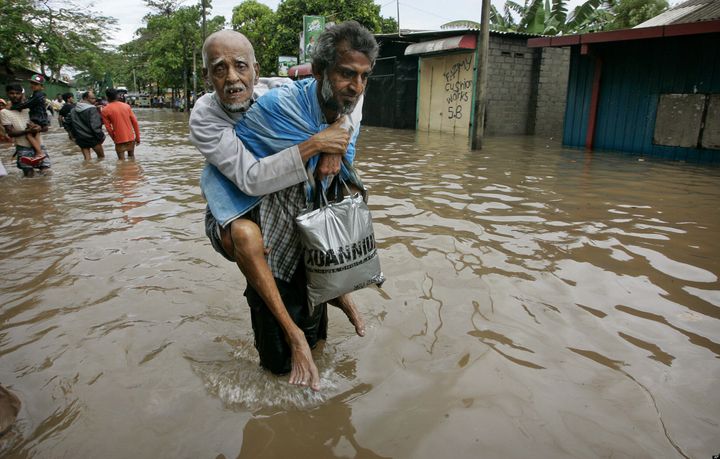
As many as 40,000 civilians may have perished in the last phase of Sri Lanka's offensive against the insurgent Tamil Tigers, with government forces blamed for "large-scale and widespread shelling," according to a new report from a UN panel established by Secretary-General Ban Ki-moon.
The Sri Lankan government, which received an advance copy of the 195-page report, had leaked sections to national newspapers, evidently to minimize the impact by denouncing it immediately. It said the report was flawed and would exacerbate any reconciliation in the island nation of 21 million people, 18 miles off the coast of India.
Sri Lanka refused to file a written rebuttal before the secretary-general's office released the full report, which said in part:
The Government shelled on a large scale in three consecutive No Fire Zones, where it had encouraged the civilian population to concentrate, even after indicating that it would cease the use of heavy weapons. It shelled the United Nations hub, food distribution lines and near the International Committee of the Red Cross (ICRC) ships that were coming to pick up the wounded and their relatives from the beaches. It shelled in spite of its knowledge of the impact, provided by its own intelligence systems and through notification by the United Nations, the ICRC and others. Most civilian casualties in the final phases of the war were caused by Government shelling.
The panel said "credible sources" estimated as many as 40,000 civilian deaths. Now the remedy is humanitarian aid, a peace commission to heal political and psychological wounds and a full-scale investigation.
Among the recommendations of the panel was that the United Nations set up another "mechanism" to probe allegations of war crimes by the government and the Liberation Tigers of the Tamil Eelam (LTTE), which the report said trapped more than 300,000 people in a human buffer zone as the Sri Lankan army advanced and also forced boys as young as 14 to join the fight.
In the archaic logic of the United Nations, the secretary-general can only establish an advisory panel. Any further fact-finding or commissions of inquiry that could lead to international prosecutions have to be mandated by a UN body, like the Security Council, the General Assembly or the Human Rights Council. Although the carefully written report could easily be called an inquiry, it is termed an advisory opinion because Ban Ki-moon ordered it on his own.
"It is a fact that if I want to establish any independent commission of inquiry, I will need to have a clear mandate from an intergovernmental body or consent of the Sri Lankan government," Ban told reporters on Tuesday after briefing the 15-member Security Council. 25 years of warfareSri Lanka, a former British colony, has been wracked by violent conflict for most of the past 25 years, suffering more than 100,000 deaths in fighting between the separatist Tamil Tigers, who traditionally lived in the northern and eastern regions, and the majority Sinhalese, who inhabit the central and southern regions. A peace process began in 2002, but talks broke down and a ceasefire agreement crumbled in 2006 when full-scale military action resumed.
The fighting escalated in 2008 and the government declared victory a year later against the Tigers that left Tamil civilians caught between opposing forces, with families separated, women raped and malnutrition rampant.
But attempts by Western nations to put it on the Security Council's agenda failed with Russia and China, saying the conflict was an internal matter. Asian powers like Japan have also been hesitant. The relatively new premise of ""responsibility to protect," to stop governments from mass atrocities against its citizens is still on shaky ground, although it was invoked against Libya. Devastating ReportStill, the report was devastating, with a number of nations pledging to follow up:
The Panel's determination of credible allegations reveals a very different version of the final stages of the war than that maintained to this day by the Government of Sri Lanka. The Government says it pursued a "humanitarian rescue operation" with a policy of "zero civilian casualties". In stark contrast, the Panel found credible allegations, which if proven, indicate that a wide range of serious violations of international humanitarian law and international human rights law were committed both by the Government of Sri Lanka and the LTTE, some of which would amount to war crimes and crimes against humanity. Indeed, the conduct of the war represented a grave assault on the entire regime of international law designed to protect individual dignity during both war and peace.
Specially the Panel found credible allegations associated with the final stages of the war. Between September 2008 and 19 May 2009, the Sri Lanka Army advanced its military campaign into the Vanni (in the Northern Province) using large-scale and widespread shelling causing large numbers of civilian deaths. This campaign constituted persecution of the population of the Vanni. Around 330,000 civilians were trapped into an ever decreasing area, fleeing the shelling but kept hostage by the LTTE. The Government sought to intimidate and silence the media and other critics of the war through a variety of threats and actions, including the use of white vans to abduct and to make people disappear.
While the UN secretary-general went out on a limb and ordered the report after other bodies in the United Nations refused to consider a probe, the panel faulted the world body for hiding the mounting casualty figures as well as not taking other action to protect civilians. "... The public use of casualty figures would have strengthened the call for the protection of civilians while those events in the Vanni were unfolding."
Another recommendation by the panel was for Sri Lanka to establish a proper commission to genuinely find out what happened in the final stages of the war. The eight-member commission created by Sri Lanka "was deeply flawed and does not meet international standards for an effective accountability mechanism," the panel said.
Now what?With the LTTE known for extreme violence (including the assassination of Indian Prime Minister Rajiv Gandhi in 1991), the group is high on terror lists of many countries. The Geneva-based UN Human Rights Council refused to recognize any abuses committed by Sri Lanka forces and passed a resolution in 2009 complimenting it rather than approving an investigation.
But one influential ambassador from a developing nation said this might not be the case in the future. The report was too damning, the envoy said, speaking on background. He said human rights groups would be using the report to pressure governments to do something.
"The Expert Panel's finding that the government and Tamil Tigers committed abuses and that the government has failed to hold its forces accountable shows the need for an international investigation," said Brad Adams, Asia director at Human Rights Watch. "Russia and China should stop blocking efforts to find justice for victims in Sri Lanka and support the panel's recommendations."
(The panel was composed of Indonesia's former attorney general, Maruzuki Darusman; American legal scholar Steven Ratner; and Yasmin Sooka of South Africa, who served on the country's Truth And Reconciliation commission. )
